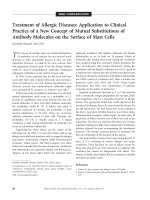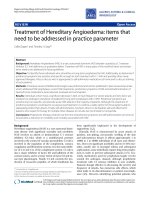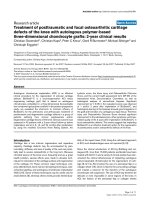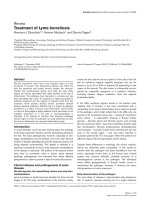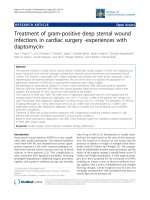Báo cáo y học: "Treatment of stasis dermatitis using aminaphtone: An unusual case of persistent groin pain after total hip arthroplasty: a case report" pdf
Bạn đang xem bản rút gọn của tài liệu. Xem và tải ngay bản đầy đủ của tài liệu tại đây (8.63 MB, 6 trang )
JOURNAL OF MEDICAL
CASE REPORTS
An unusual case of persistent groin pain after
total hip arthroplasty: a case report
Konala et al.
Konala et al. Journal of Medical Case Reports 2011, 5:67
(15 February 2011)
CAS E REP O R T Open Access
An unusual case of persistent groin pain after
total hip arthroplasty: a case report
Praveen Konala
1
, Thomas K Schaefer
2
, Farhad Iranpour
1
, Niklaus F Friederich
2
, Michael T Hirschmann
1,2*
Abstract
Introduction: Arthroplasty is a well-established routine elective surgical procedure in orthopaedics. To a great
extent, diagnosis, treatment and post-operative rehabilitation in these patients is standardised. In a busy clinic,
surgeons from time to time tend to focus their attention on common causes of joint pain, but it may lead them
to overlook sinister but less common pathologies. Here we report a case of a patient with groin pain due to pre-
operatively undetected pelvic metastases from a pyeloureteral carcinoma who underwent total hip arthroplasty.
There are several case reports which deal with primary or secondary tumours which were either discovered at the
time of replacement surgery or developed at the site of prosthesis years after total hip or knee replacement. To
the best of our knowledge, this is the first case report in which a metast atic cancer was missed pre-operatively and
intra-operatively both by the radiologist and by the orthopaedic surgeon and should be reported so that surgeons
are reminded to be careful when dealing with seemingly routine cases.
Case presentation: A 79-year-old Caucasian woman presented to the arthroplasty clinic with groin pain. Initial
radiographs showed subtle bi lateral abnormalities in the pelvis. Neither the radiologist nor the orthopaedic
surgeon recognized it. A diagnosis of osteoarthritis of the hip was established, and she underwent total hip
arthroplasty. Despite initial improvement, the patient came back with worsening hip pain three months later.
Further radiological examination revealed multiple metastatic lesions throughout the pelvis due to a pyeloureteral
carcinoma.
Conclusions: This case report emphasizes the importance of meticulous, unbiased pre-operative assessment of
patients and their radiographs, even in so-called routine clinical cases. Often subtle radiological changes are classed
as normal, especially if they are bilateral. Further radiological imaging should be recommended in all cases where
unexplained clinical features or radiological findings are present.
Introduction
Total hip arthroplasty (THA) is a well-established rou-
tine surgical procedure in orthopaedics [1-3]. To a great
extent, diagnostics, treatment and postoperative rehabili-
tation in these patients are standardised [1-3]. In a busy
hip clinic, surgeons from time to time tend to focus
their attention on common causes of hip pain, but it
may lead them to overlook other sinister but less com-
mon pathologies.
Here we report a case of a patient with groin pain due
to pre-operatively undetected pelvic me tastases from a
pyeloureteral carcinoma who underwent THA. There
are several case reports that deal with primary or
secondary tumors which have either been discovered at
the time of replacement surgery or develope d at the site
of prosthesis years after total hip or knee replacement
[4-9]. To the best of our knowledge, this is the first case
report in which a metastatic cancer was missed pre-
operatively and intra-operatively both by the radiologist
and by the orthopaedic surgeon and should be reported
so that surgeons are reminded to be careful when deal-
ing with seemingly routine cases.
Upper urinary tract t umours are uncommon a nd con-
stitute 5% to 7% of all urinary tract tumours [10]. A ratio
of 56% to 98% of patients with pyeloureteral carcinoma
present with microscopic or macroscopic haematuria
[11]. Around 30% present with flank pain, and 19% pre-
sent with features of advanced disease, including bone
pain, anorexia and weight loss. The thin layer of smooth
* Correspondence:
1
Musculoskeletal Surgery Department, Imperial College, London, UK
Full list of author information is available at the end of the article
Konala et al. Journal of Medical Case Reports 2011, 5:67
/>JOURNAL OF MEDICAL
CASE REPORTS
© 2011 Konala et al; lic ensee BioMed Central Ltd. This is an Open Access article distributed under the terms of the Creative Commons
Attribution License ( which permits unrestricted use, distribution, and reproduction in
any medium, provided the original work is properly cited.
muscle around the upper urinary tract predisposes these
patients to early local inv asion and metastasis. Urothelial
tumours spread by local invasion as well as lymphatic
and haematogenous spread. The incidence of bone
metastasis in upper urothelial tumours is hard to com-
pute in view of its rarity and the lack of large dat a sets.
Studies of m etast atic urinary tract tumo urs b y Senge løv
et al. [12,13] showed that the most common sites of
metastasis are lymph nodes (26%-57%) and bone (35%-
40%). Among those with bone metastasis, the spine was
involved in 40% of the cases, followed by pelvis in 26%
[12,13].
Figure 1 Pre-operative antero-posterior pelvic (left) and true lateral (right) radiographs of the left hip showing bilateral osteoarthritis
of the hip and a calcified uterine myoma.
Figure 2 Initial postoperative antero-posterior pelvic (left) and true lateral (right) hip radiographs with acceptable implant p osition.
Konala et al. Journal of Medical Case Reports 2011, 5:67
/>Page 2 of 5
Case presentation
A 79-yea r-old, active Caucasian woman with left groin
pain was referred to the orthopaedic clinic by her general
practitioner to undergo THA. She complained about pro-
gressive left groin pain for 12 months that was worst in
the morning and exacerbated by physical activity and pro-
longed sitti ng. Clinical examination revealed left-sided
antalgic gait and tendern ess in her left groin. Left hip
internal rotation was limited to 10°. Anteroposterior pelvic
and true lateral hip radiographs revealed typical signs of
Figure 3 Comparison of anteroposterior pelvic hip radiographs preoperatively and six weeks and three months post-operatively (from
left to right).
Figure 4 A technetium-99 m bone scan revealed widespread osteolytic and osteoblastic lesions in the entire pelvis, spine and chest.
Konala et al. Journal of Medical Case Reports 2011, 5:67
/>Page 3 of 5
osteoarthritis (Figure 1). In addition, there was a 25-mm-
diameter calcification in the lesser pelvis, which was
reported by the radiologist to be a calcified uterine
myoma. Finally, the patient was scheduled for elective left
THA. At the preadmission clinic, a routine urine dipstick
test revealed 3 to 20 erythrocytes and no leucocytes or
nitrites. On the basis of the urine dipstick stick, a diagnosis
of urinary tract infection (UTI) was made, although the
patient was asymptomatic and urine was sent for culture.
The patient was empirically treated with oral antibiotics,
and the surgery was postponed. Urine cultures showed no
bacterial growth, and no further tests or referral to other
specialties were done. Four weeks later she underwent a
THA with satisfactory recovery. At the first follow-up si x
weeks postoperatively, t he patient was almost pain-free
and was using two crutches for stability. Her examination
was unremarkable at that time. Standard radiographs
showed an acceptable implant position (Figure 2).
The orthopaedic surgeon and the radiologist did not
report any other abnormality. Further physiotherapy was
recommended, and routine follow-up was recomme nded
six months from the time of surgery. Unexpectedly, the
patient p resented to us four months after surgery com-
plaining of worsening left hip pain. Because she was still
on crutches, she noted weakness, loss of appetite and
weight loss of 5 kg. Further examination revealed general-
ized tenderness of the left i liac crest, gluteal region and
groin. The radiographs then showed bilateral cloudy bone
formation in the pelvis (Figure 3). Further investigation
with a technetium-99 m bone scan and computed tomo-
graphy (CT) revealed widespread osteolytic and osteoblas-
tic l esions bilaterally in the superior and inferior pubic
ramii, sacrum, iliac wings, acetabula and left transverse
process of the L4 and L5 vertebrae, which were most likely
metastatic (Figures 4 and 5). Screening for the primary
tumor (CT of the chest abdomen and pelvis) revealed a
left pyeloureteral carcinoma. No further invasive tests or
histopathological examinations were done beca use of the
advanced stage of the disease, and a decision was made to
provide palliative treatment to the patient. The patient
Figure 5 Computed tomography confirmed the widespread osteolytic and osteoblastic lesions in the entire pelvis, spine and chest.
Konala et al. Journal of Medical Case Reports 2011, 5:67
/>Page 4 of 5
received palliative chemotherapy and radiotherapy and
died one year after diagnosis.
Discussion
Many case reports have been published with regard to
tumours developing at the site of arthroplasty [4-9]. It may
be assumed that in these cases, the tumour was already pre-
sent pre-operatively and could have been detected by more
extensive clinical and radiological investigation. In our case,
even retrospectively it is hard to pick up the pathology on
the initial pelvic radiographs, b ut a closer look reveals an
abnormal texture of both pubic bones. This was considered
normal, however, as it appeared bilaterally. In addition, the
calcified myoma distracted the surgeons’ and radiologists’
attention. A comparison with a norm al pelvic radiograph
from another patient could have been helpful and might
possibly have resulted in an earlier diagnosis.
Interestingly, the patient’ ssurgerywaspostponed
because of microscopic haematuria, which was inter-
preted as a lower UTI. However, haematuria is one of
the most common findings in urothelial carcinoma,
although it is not specific and is also present in cases
of UTI [ 14]. The question whether our patient’spreo-
perative symptoms were caused in tot al or at least in
part by the osteoarthritis is difficult to answer, but the
initial clinical presentation as well as the fact that the
patient was temporarily pain-free after THA points in
that direction. During surgery, no abnormal bone pre-
sentation was detected in the hip joint, which f urther
supports this theory, although it is highly likely that
the metastases were pre sent at the time of initial pre-
sentation. Whether the surgery may have led to a
more rapid progression of the metastatic disease
because of compromise of the immune system remains
unclear. On this issue, no evidence is available in the
literature.
Conclusion
This case report is of particular importance to all radiol-
ogists and any surgeon involved in elective orthopaedic
surgery. It highlights the importance of avoiding the
pigeon-holing of patients with specific symptoms into
specific diagnostic categories to correctly diagnose the
outliers. Further, radiographs should be analyzed in a
systematic, standardized and complete manner, taking
every visible structure into account. In the presence of
bilateral subtle abnormalities, further radiological ima-
ging such as magnetic resonance imaging or single
photon emissio n tomography should be recommended.
In conclusion, the importance of an unbiased assess-
ment of patients and their radiographs is a sine qua non
for the establishment of the correct diagnosis.
Author details
1
Musculoskeletal Surgery Department, Imperial College, London, UK.
2
Department of Orthopaedic Surgery and Traumatology, Kantonsspital
Bruderholz, CH-4101 Bruderholz, Switzerland.
Authors’ contributions
PK reviewed the case and drafted the manuscript. FI participated in drafting
the manuscript and case review. TS participated in drafting the manuscript
and literature review. NFF participated in drafting the manuscript and case
review. MTH reviewed the case and drafted the manuscript. All authors read
and approved the final manuscript.
Competing interests
The authors declare that they have no competing interests.
Consent
Written, informed consent was obtained from the patient for publication of
this case report and accompanying images. A copy of the written consent is
available for review by the Editor-in-Chief of this journal.
Received: 11 February 2010 Accepted: 15 February 2011
Published: 15 February 2011
References
1. Recommendations for the medical management of osteoarthritis of the hip
and knee: 2000 update. American College of Rheumatology Subcommittee
on Osteoarthritis Guidelines. Arthritis Rheum 2000, 43:1905-1915.
2. McAlindon T, Zucker NV, Zucker MO: 2007 OARSI recommendations for
the management of hip and knee osteoarthritis: towards consensus?
Osteoarthritis Cartilage 2008, 16:636-637.
3. Misso ML, Pitt VJ, Jones KM, Barnes HN, Piterman L, Green SE: Quality and
consistency of clinical practice guidelines for diagnosis and
management of osteoarthritis of the hip and knee: a descriptive
overview of published guidelines. Med J Aust 2008, 189:394-399.
4. Visuri T, Pulkkinen P, Paavolainen P: Malignant tumors at the site of total
hip prosthesis: analytic review of 46 cases. J Arthroplasty 2006, 21:311-323.
5. Vadivelu R, Kar N, Margetts MJ, Abdul-Cader AH: Non-Hodgkin’s lymphoma
as an unexpected diagnosis in a hip arthroplasty. Arch Orthop Trauma
Surg 2002, 122:532-534.
6. Prasad PS, Latham JB, Tucker JK, Ball RY: Disseminated osteosarcoma
arising in the pelvis after total hip arthroplasty. J Arthroplasty 2002,
17:373-378.
7. Martin A, Bauer TW, Manley MT, Marks KE: Osteosarcoma at the site of
total hip replacement: a case report. J Bone Joint Surg Am 1988,
70:1561-1567.
8. Billings SD, Wurtz LD, Tejada E, Henley JD: Occult sarcoma of the femoral
head in patients undergoing total hip arthroplasty: a report of two
cases. J Bone Joint Surg Am 2000, 82-A:1536-1539.
9. Fehring K, Hamilton W: Metastatic carcinoma as an unusual cause of
knee pain after total knee arthroplasty: a case report. J Bone Joint Surg
Am 2009, 91:693-695.
10. Jemal A, Tiwari RC, Murray T, Ghafoor A, Samuels A, Ward E, Feuer EJ,
Thun MJ, American Cancer Society: Cancer statistics 2004. CA Cancer J Clin
2004, 54:8-29.
11. Raabe NK, Fosså SD, Bjerkehagen B: Carcinoma of the renal pelvis:
experience of 80 cases. Scand J Urol Nephrol 1992, 26:357-361.
12. Sengeløv L, Kamby C, von der Maase H: Pattern of metastases in relation
to characteristics of primary tumor and treatment in patients with
disseminated urothelial carcinoma. J Urol 1996, 155:111-114.
13. Sengeløv L, von der Maase H, Kamby C, Jensen LI, Rasmussen F, Horn T,
Nielsen SL, Steven K: Assessment of patients with metastatic transitional
cell carcinoma of the urinary tract. J Urol 1999, 162:343-346.
14. Patschan O, Horstmann M, Thomas C, Schlemmer HP, Stenzl A: [Diagnostic
procedures in upper urinary tract urothelial carcinoma] (in German).
Urologe A 2008, 47
:1487-1496.
doi:10.1186/1752-1947-5-67
Cite this article as: Konala et al.: An unusual case of persistent groin
pain after total hip arthroplasty: a case report. Journal of Medical Case
Reports 2011 5:67.
Konala et al. Journal of Medical Case Reports 2011, 5:67
/>Page 5 of 5

